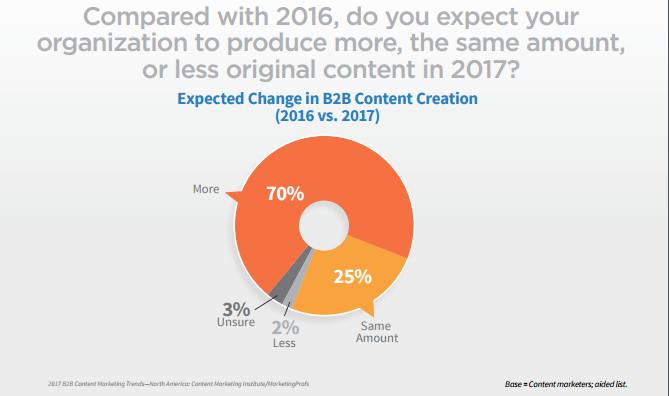9 Trends in Marketing Asset Management Technology

Marketing Asset Management is a system used by national and global companies to improve how they store, locate and distribute their marketing materials effectively.
In today’s fast-paced, ever-evolving world, companies must be agile to stay relevant, let alone ahead. Marketers have their work cut out for them with growing demands of content creation, management and strategy. According to the Content Marketing Institute, 70% of B2B marketers plan to create more content in 2017 compared to 2016. As a result, a new system – marketing asset management – has emerged to enable companies to store, locate and distribute marketing materials.
Luckily, there are many tools to help with these growing demands and systems. Finelink is one such tool. It’s a web-based digital asset management solution that allows you to create, store, share, edit and print assets on demand. It can be further customized to meet virtually every marketing need an organization might have–all under one online platform. Request a Finelink overview today to learn more.
As if the growing lists of channels and action items weren’t enough to keep track of, marketing asset management will face future changes as well–all the more reason to invest in a solution like Finelink to keep ahead of the competition.
Here are 9 trends in marketing asset management technology to watch out for in the coming months.
1. Faster Marketing Implementation
Let’s face it: we want everything now. We’ve grown accustomed to the on-demand economy. Your customers are no different, and with all the content coursing through social media, those expectations are held to marketing just the same. You have to be quick, else you’ll be forgotten.
The same is true for marketing asset management, as it is for all technology. Users want to see improved processing speed, a streamlined experience and faster results. The technology that delivers this will be favored.
For marketers, it goes one step further. They need solutions that allow them to manage all their marketing assets as fast and efficiently as possible to keep up with production. That means simple, easy-to-use tools that work in harmony.
In a market crowded with messages 24/7, it becomes a race to get the right the message to the right audience at the right time. Make sure you pack your running shoes.
2. Mobile Marketing
A few statistics to consider:
-
68% of companies have integrated mobile marketing into their overall marketing strategy (Salesforce)
-
71% of marketers believe mobile marketing is core to their business (Salesforce)
-
Mobile advertising will represent 72% of all US digital ad spending by 2019 (Marketing Land)
-
Average smartphone conversion rates are up 64% compared to average desktop conversion rates (CMS Report)
-
91% of mobile users say that access to content is very important (Wolfgang Jaegel)
See the trend here? Mobile use is growing exponentially. Marketing asset management solutions will need to provide users with the ability to create, edit, store, share and post assets through mobile channels. Furthermore, as mobile users themselves, marketers will expect to see mobile platforms that allow them to handle all their marketing asset management needs on the go.
3. Customizable Management Systems
The future brings many things. Among the most certain, and sometimes the most dreaded, is change. That’s when we start to hear buzzwords like change management being muttered around the office, perhaps accompanied by a few gasps.
But there’s no reason to stress. Especially if you prepare.
What does this mean for marketing asset management?
It means that marketing asset management solutions need to be flexible. They have to offer customization options as an organization changes. Solutions that include custom programming and dedicated IT support will help companies evolve in new climates.
4. Global Campaign Measurement & Tracking
Metrics matter. Marketers know this more than most. We’ve seen metrics included in all kinds of marketing solutions, and for good reason: they give marketers insight into what’s working, what’s not. Metrics allow marketers to adjust their efforts accordingly, with the end goal of driving the results they’re after.
We can expect to see metrics integrated, to some degree, with marketing asset management solutions. Metrics of interest will vary. Some marketers might want to see how many of their colleagues like or share their assets. Others might want to track how many assets are being printed on demand.
With our data-driven mindset, one thing is clear: marketers expect to see some numbers to help them make future decisions.
5. Marketing Automation
Our workloads aren’t getting any lighter. In fact, with the rise of technology, we’re finding more and more tasks we have to manage (social media, SEO, etc.).
But we don’t have to spread ourselves too thin: that’s where automation lends a hand.
Expect to see automated marketing asset management in a variety of ways. From the use of templates, to auto-populating data, to scheduling orders of materials throughout the year, to automating the production and storage of creative assets, automation will streamline marketing asset management as it will other technologies. With these changes, marketers might have more time to invest in creative activities.
6. Technology Integration
Integration is a big feature of most solutions nowadays. Users need solutions that can integrate with each other, rather than working in silos. This is also the case with marketing asset management, which will require integration with social media, ERPs, CRMs and more.
Integrating several solutions into one unit helps streamline the workflow. It pulls the resources from each unit for use in others and helps save time and money.
7. Consolidating Marketing Content
With the rise in content creation, employees are spending large amounts of time searching for content: between 6.5 to 8.8 hours per week.
That time could be reduced exponentially by having a database where users can store and share all their content and assets, bringing everything together into one location. That’s one of the big advantages marketing asset management brings to the table, but marketers want to see this taken a step further. The use of tagging, search and filter functions will help users dial into exactly what they need and get it as quick as possible.
With those kinds of tools, searching for content should only take minutes, not hours.
8. Scaling Marketing Efforts
Companies are growing and shrinking all the time. In today’s world of technology, that presents a few challenges. Companies might outgrow or need to downsize their current solutions.
To help navigate these challenges, companies need solutions that can scale with them. That is another element of flexibility marketers will expect to see from marketing asset management systems. A solution that can scale with a company through its life cycle will be highly valued.
9. AI
AI is already paving the way for the future. It allows us to take our hands off the wheel and let the machine drive for a change. This helps with any monotonous tasks users might face. Many times AI handles these tasks more efficiently than we ever could.
This need will present itself in various forms throughout marketing asset management. AI can assist with content curation, content generation, research and SEO. We’ve only just begun to explore the uses of AI, however. We can expect that functionality to develop over time.
Be sure to look out for these 9 trends. The future is always dawning, and for marketing asset management technology, the future looks bright.
Request a Finelink overview today to learn more about how you can start leveraging your marketing assets.





